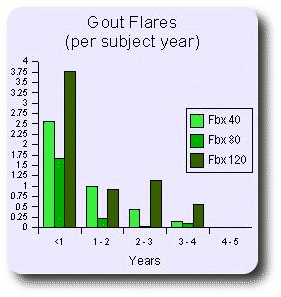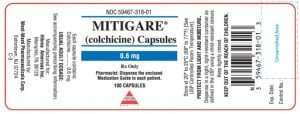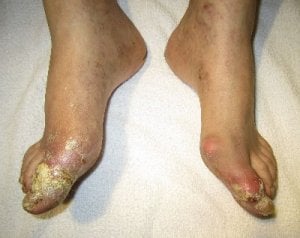We know that lowering uric acid is the only way to remove the risk of more gout attacks and joint damage. Also, we know that, once a gout attack has occurred, we must keep uric acid at, or below, 5mg/dL. Finally, we know that uric acid crystal deposits will dissolve faster at lower uric acid levels.
How Does Lowering Uric Acid Cause More Gout Attacks?
Many people who start taking uric acid lowering treatments are surprised to see gout attacks increasing.
Because they feel pain in many joints, Also, gout pain often affects joints that haven’t had problems before.
Good doctors will prescribe pain relief for the first few months of treatment for lowering uric acid. But why do we need this?
Many years ago, I learned that dissolving uric acid crystals are just as likely to cause gout as newly formed crystals. So, I published Allopurinol Medication: Why It Hurts To Get Rid Of Gout, which is the cornerstone of my approach to fixing gout. Though the article features allopurinol, the process applies to any method for lowering uric acid. Now, we have newer medical options besides allopurinol and probenecid. Also, the process applies to lifestyle improvements that reduce uric acid. So my view is that you cannot manage a gout diet by tracking foods that trigger gout attacks. Because you cannot tell if the attack is caused by new crystals forming, or by old ones dissolving.
Correct way to Lower Uric Acid
The only way to measure the effectiveness of lowering uric acid is to test the blood. For most gout patients, this means a lab test by your doctor. Uric acid tests should be monthly at first, and always at least once per year. For gout sufferers trying to manage gout through improved food and other lifestyle choices, you should test more often. So a home uric acid tester is usually essential.
Now, many people successfully fix their gout and gain the freedom of pain-free lives. For some, it is a straightforward process. But, for others, it is a painful time, although manageable with appropriate pain relief. For almost all, it is a mystery why pain should be more widespread when first lowering uric acid, and a mystery why pain occurs in joints that were previously pain-free.
Uric Acid Pain Pathway
When you understand the gout pain pathway that I describe in the Uric Acid Section, the mystery is solved.
Uric acid crystals form deposits quite slowly. I will present some facts on this in a separate article. The main point to bear in mind is that uric acid crystals can form without causing immediate pain. It is only when there are sufficient numbers of crystals that our immune system calls for reinforcements and the exquisitely painful inflammation ensues. We know from recent research using advanced scanning techniques that uric acid deposits exist in many more joints than the ones that show painful gout symptoms (search for DECT in the search box above). We also know from our own experiences and hundreds of medical reports, that gout is a progressive disease, affecting more and more joints each year.
Over years of untreated gout, we experience gout in one joint, then another. As the crystals form that cause the acute gout flare, uric acid moves out of the blood and crystals stop forming. Hence, gout attacks from newly formed crystals rarely affect more than one or two joints. However, lowering uric acid to levels below 6.8mg/dL (0.40mmol/L) will start the dissolving process throughout the body. Partially dissolved uric acid crystals are just as much a target for the immune system as the newly formed ones are. This explains why gout attacks during lowering uric acid are more widespread. Also, joints that have had a very slow, unnoticeable, build up of uric acid, might experience a sudden partial dissolving of many crystals that can trigger an attack.

Minimize Gout Pain during lowering uric acid treatment
So can we do anything to minimize gout pain during lowering uric acid treatment?
There are several things we can do:
- Take daily colchicine for a week before starting treatment or increasing dose, and continue for a week, then at the first sign of a gout flare. This will slow the immune system and reduce the chances, intensity, and length of gout flares.
- Support the colchicine with NSAIDs and/or other pain relief when required. Seek advice from your doctor or pharmacist about effective combinations.
- Get uric acid levels down to 5mg/dL (0.30mmol/L) as soon as possible. I mention 6.8 as the crystallization point, but this is temperature dependent, so will be less when colder. Also, dissolving crystals will push blood uric acid levels back up again. 6mg/dL (0.36mmol/L) has been a common benchmark for many years, but it is now recognized that this gives insufficient safety margins for fluctuating levels, so 5 is the safe standard.
- Consider lower levels to dissolve uric acid crystals quicker. Getting below 5 for a few months will shorten the time period that you are exposed to risks of gout attacks.
Share your experiences about lowering uric acid in the Gout Forum and read how other gout sufferers learn to lower uric acid safely.
Leave this Lowering Uric Acid page to browse the Uric Acid Section.
Please give your feedback
Did this page help you? If yes, please consider a small donation. Your donations help keep GoutPal's gout support services free for everyone.
If not, please tell me how I can improve it to help you more.
- YouTube
- The gout forums.











